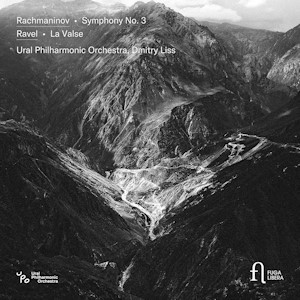
Sergei Rachmaninov (1873-1943)
Symphony No. 3 in A minor, Op 44 (1935-1936)
Maurice Ravel (1875-1937)
La Valse (1919-1920)
Ural Philharmonic Orchestra/Dmitry Liss
rec. 2022, Grand Hall of Sverdlovsk Philharmonic, Yekaterinburg, Russia
Reviewed as 16-bit download
Fuga Libera FUG821 [53]
The recording by the same forces of Rachmaninov’s Second Symphony was highly recommended last year by me (review) and another colleague (review), so I was eager to hear this latest release.
I have in the past enthusiastically endorsed recordings of this symphony by both Pletnev and the Russian National Orchestra (review) and Wilson with the Sinfonia of London (review), and I agree with John Quinn’s review of the version by Petrenko with the RLPO on EMI (review), so we are to some degree already spoilt for choice. It is not the easiest of Rachmaninov’s three symphonies to appreciate; it is loose, episodic and somewhat inclined to sprawl and our perception of the work is perhaps coloured by the knowledge that the gloomy composer was so missing his homeland during its composition, but after the plaintive Lento lament opening the first movement, which sounds very Mussorgskian, as if based on an old chant, the orchestral outbursts lift the spirits, then the sinuous beauty of the cello melody beginning just a couple of minutes in is balm to the ears. That false comfort is soon dispelled by the agitation which sets in three minutes later and the remainder of the movement is restless, questing and melancholy until the return of that cello melody eleven minutes in. As with the recording of the Second Symphony, Liss doesn’t dawdle or sentimentalise any passage in this bewilderingly disorienting succession of ideas. The fast section beginning half way through the middle movement Adagio is a Scherzo in all but name and Liss drives it hard, which works. The finale is mercurial and even puzzling, incorporating disparate elements such as the central fugato section, variations of the omnipresent Dies irae leitmotif, brittle marches, then yearning folksy dances; Liss and his orchestra deliver them all with confidence and élan.
Indeed, the Ural Philharmonic plays with great clarity of line and unanimity within the conductor’s flexible beat; this is a crack outfit. That transparency is also facilitated by the excellent engineering balance; every line is as clear as if one were sitting in the front seats of a concert hall.
The notes are somewhat gnomic and fanciful; I hardly know what to make of statements like, “The interiority, the quasi scherzo nature of the images flashing past in this music can cause one to think about the multitude of meanings that the author must have encoded in it” – but let that pass; this is as fine an account as any of a strange work which will never achieve the popularity of its predecessor from thirty years earlier but exercises a certain fascination.
La Valse makes a suitably moody and macabre pendant to the main offering here; its feverish, obsessive nature complements the symphony’s restlessness and sense of unravelling. Liss’ deployment of rubato is subtle and telling; nothing about this sly, refined playing is suggestive of the orchestra being Russian in character.
Ralph Moore
Buying this recording via a link below generates revenue for MWI, which helps the site remain free



















